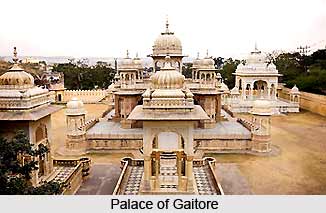 The Gaitore is among the most well-known tourist attractions in Jaipur known for its stunning blend of Islamic and Hindu style of architecture and is famous for its cenotaphs or `Chattris`, well known as Gaitore Chattris. The name Gaitore is correctly pronunced as `Gaye ka Thor` which means resting place of departed souls. Gaitore is the name of a majestic cremation ground where the bodies of kings were buried. In the memory of every king a cenotaph was constructed.
The Gaitore is among the most well-known tourist attractions in Jaipur known for its stunning blend of Islamic and Hindu style of architecture and is famous for its cenotaphs or `Chattris`, well known as Gaitore Chattris. The name Gaitore is correctly pronunced as `Gaye ka Thor` which means resting place of departed souls. Gaitore is the name of a majestic cremation ground where the bodies of kings were buried. In the memory of every king a cenotaph was constructed.
History of the Gaitore
The beautiful site was designed by Maharaja Sawai Jai Singh II, after he (Maharaja Sawai Jai Singh II) shifted his capital to Jaipur in 1733. From 1733 the cremation of every Kachhwaha king was done here. The only cenotaph which is missing from here is the one of Maharaja Sawai Ishwari Singh whose cremation was done in the city palace complex in Jaipur.
Architecture of the Gaitore
The cenotaphs nicely juxtapose the architectural features of both Islamic tomb and temple architecture of Hindu temple. Significant chhatris of Gaitore are those devoted to Sawai Ram Singh, Sawai Madho Singh and Sawai Jai Singh. Amongst them, one devoted to Maharaja Sawai Jai Singh II is significant. For building this cenotaph, pure white marbles, embellished with subtle cuttings, peacocks and stunning patterns are used. Each and every cenotaph is exquisitely designed in remembrance of a specific king thereby representing the style and culture of their times.
The Gaitore is the final relaxing place of the Kachhwaha Rajput monarchs, which takes people back to the wonderful royal heritage of the kings of Jaipur. Its cenotaphs are a perfect blend of Hindu temple and Islamic architecture and which have attracted the attention of Indian as well as foreign tourists.
This article is a stub. You can enrich by adding more information to it. Send your Write Up to content@indianetzone.com



















